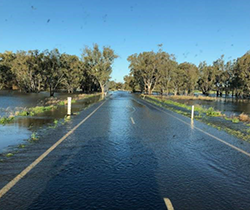Being prepared this summer
The Bureau of Meteorology has announced an even chance that La Nina will return in spring, posing a flood risk to already wet catchments this summer.
The EPA has been calling on licensees and industry to be ready for severe weather or other seasonal events this summer, and to ensure they have their emergency response plans in place.
The Bureau of Meteorology states that “predictions for a wetter and warmer spring for the country’s east come after a particularly wet and warm winter”.

The EPA urges people to prepare for likely heavy weather which can flood dams and causeways
The EPA is aware that dams in some areas such as Burrendong near Dubbo, Wyangala near Cowra and Chaffey near Tamworth are already being managed at near full capacity.
EPA’s Executive Director Regulatory Operations Stephen Beaman is urging licensees and all businesses to be ready to activate their Pollution Incident Response Management Plan (PIRMP).
“Run through your PIRMP and make sure your staff are aware of the expected conditions over the coming months,” Stephen said.
“Your staff need to know emergency evacuation procedures and their roles and responsibilities under your plan.
“Premises that contain sediment and erosion control dams should ensure water levels are being managed in a way that enables inflows, and that all sediment and erosion controls are maintained to ensure they are stable in high stormwater conditions.
“If you are the owner of a declared dam you are also reminded to review your operations and maintenance plan, and emergency plan, to ensure you are prepared for abnormal operating conditions and flood risks.
“Licensees and landowners on flood prone land should secure or remove property, including chemical storage containers, from low lying areas to prevent them being washed away in floodwater.
“Chemical storage containers were one of the big types of waste removed by contractors cleaning up waterways and shorelines after the March 2021 floods.”
Call to Action:
- If you undertake high-risk activities, ensure you have proper monitoring and controls in place to minimise potential impacts.
- Keep up to date with the latest information on bushfires and for floods and storms .
- If you have questions or need assistance around environmental protection, contact the EPA at info@epa.nsw.gov.au or by phone 131 555.
- Check out this handy explainer on Reporting incidents
Tips for everyone
- Practically manage household waste to keep pests and odours at bay. Report industrial odours – see the fact sheet on how to report.
-
Summer means more cool drinks – and more empty bottles. Remember to take your empty bottles and cans to a Return and Earn collection point. Avoid the busy times on weekends if you can.

